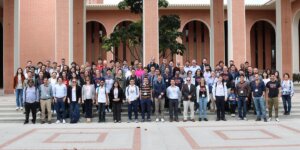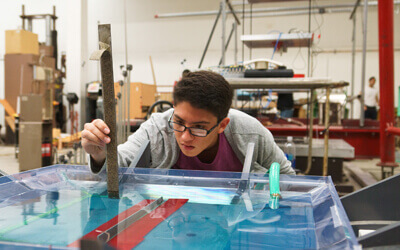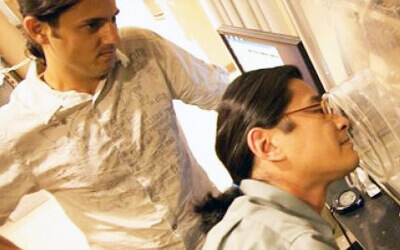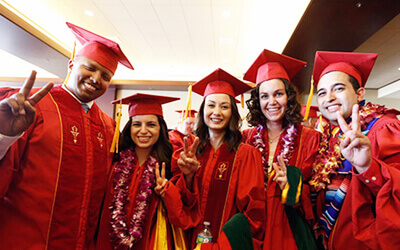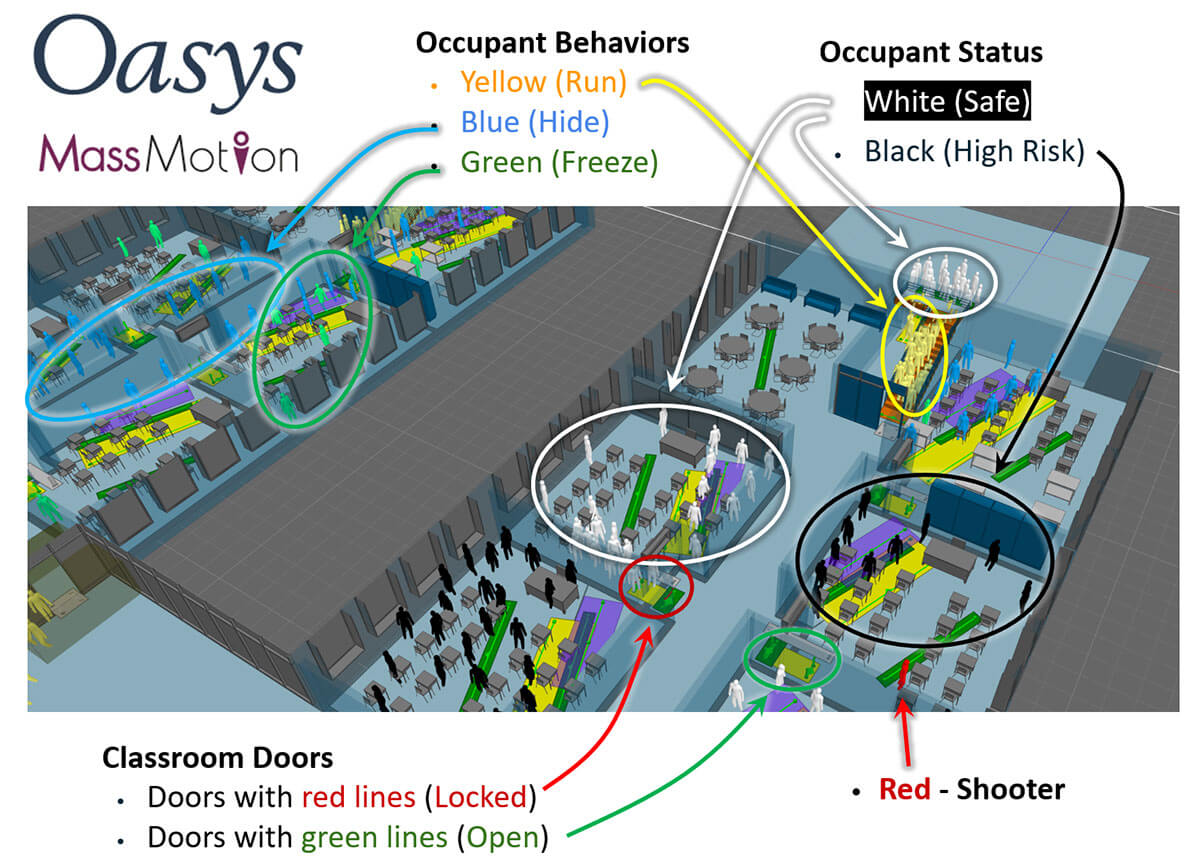
MassMotion simulation setup of building occupants, shooter and environment
How do you visualize the unimaginable – and plan accordingly?
Active shooter incidents (ASI) provide a devastating example of the insufficiency of our survival instincts. In situations of threat, the prefrontal cortex — the part of the brain we use for executive decision-making) is inhibited — resulting in confusion and narrowing of perspective.
Here’s where simulation software can help, leveraging the lived experience of human beings to model multiple scenarios and response options. Technology alone is not enough; striking the right balance for a human-AI collaboration requires a research-based approach grounded in hard data.
From insight to simulation
With the support of an NSF Smart and Connected Communities Integrative Research Grant, a team of researchers at the USC Viterbi School of Engineering have developed an in-depth and innovative process for data-sourcing that can be channeled into simulation software such as the crowd-simulator, MassMotion.
The goal? To identify how people instinctively respond to active shooter incidents and fires; and to use the simulations both as training materials and models to inform the design of safer buildings and more effective emergency protocols.
“We recognized the need for a simulation tool which allows us to test the many variations in behavioral responses and building features, serving as a support mechanism for decision makers to evaluate different strategies,” said Burçin Becerik-Gerber, the principal investigator of the project and chair of the Sonny Astani Department of Civil and Environmental Engineering (CEE). “These simulation outputs typically take the form of 2D or 3D animations or rendered video clips, which can be used for analysis, presentation or training purposes.”
The team is collaborating with ARUP, the globally recognized engineering firm, and the developers of MassMotion. This collaboration is instrumental not only in ensuring technical rigor and realism in the simulation work, but also in bridging the gap between research and real-world applications.
“By leveraging a commercially available and industry-validated platform like MassMotion, our findings can be more readily adopted in practice, enabling immediate impact in design workflows, policy development and emergency preparedness planning,” said Becerik-Gerber. “We are deeply grateful for ARUP’s partnership, which brings critical insight and translational potential to this effort.”
Evolve and survive
The research builds upon previous USC initiatives related to emergency situations in the built environment, including creating virtual replicas of Keck Hospital of USC for interactive ASI-defense training.
While the new series of simulations aren’t designed for live user engagement — focusing instead on scenario modelling and output visualization — the process of data gathering is rooted in human lived experience. The EVOLVE (Elicitation and Verification of Learning via Experts) method was developed by the team to tap into the insights of expert stakeholders, including professionals from law enforcement, emergency management and building design.
“EVOLVE is a new tool we have created to access researchers’ toolkits,” said Gale Lucas, research associate professor at the USC Institute for Creative Technologies (ICT) and a specialist in the emotional nuances of human-computer interaction. “Using this recently validated method, researchers, including myself and my colleagues, can systematically elicit and capture stakeholder perspectives, priorities and lived experiences.”
Academic papers demonstrate a surprising lack of systematic empirical evidence detailing human behavior in response to ASIs. EVOLVE seeks to change that. Through structured activities such as tabletop exercises, timeline mapping, and scenario walkthroughs, the team gathered qualitative data on how participants perceive and respond to emergency situations, such as evacuation routes, decision points, bottlenecks and communication dynamics.
Over the course of two multi-day workshops of 18-20 participants, the team identified five categories of influencing factors: individual-related, building-related, situation-related, security-related and shooter-related factors. The network of factors is conditioned by six types of civilian responses: running following a crowd, hiding in place, running then hiding, running independently, freezing and fighting.
From information to simulation
While “running with a crowd” was the most common behavior (28%), a substantial share of civilians responded by hiding in place (26%) or freezing (12%) – passive responses often overlooked in planning and training exercises. Fighting, typically presented as a last resort, accounted for only 10% of observed behaviors.
These patterns highlight a crucial point: civilians often act based on limited information, instinct, and environmental cues, rather than formal protocols. Situational awareness is frequently compromised by unfamiliar architecture, stress, or conflicting signals.
This data was then applied to define the parameters and logic of the simulations, generating realistic crowd movement patterns and decision-making pathways. The result is a set of realistic scenarios that reflect community-informed conditions and challenges, grounding the simulations in real-world contexts and making them more useful for future planning and evaluation.
“Communication and social influence play a critical role in high-stakes crowd simulations such as active shooter scenarios,” said Volkan Ustun, a research scientist at ICT who is leading the development of the simulations. “Traditional agent-based models often struggle to capture and explain the nuanced, emergent social dynamics in these environments.”
Recent advances in Large Language Models (LLMs) have enabled the creation of generative agents with human-like cognition, memory, communication and decision-making – offering a more adaptive, expressive and interpretable foundation for dynamic, context-aware simulations.
Yet despite their richness, LLM-generated behaviors often diverge from expert expectations, exposing a behavior-realism gap.
“Our work addresses this by iteratively refining agent personas to allow them to match real-world benchmarks such as EVOLVE data,” said Ustun. “These agents bring us closer to building transparent, trustworthy and context-sensitive simulations for training, policy testing and beyond.”
From reactive to responsive
In a world where ASI can unfold in under five minutes, survival often depends less on what individuals know and more on what their environments allow them to do. By bridging behavioral science, architectural design and emergency response, the project shifts the conversation from reaction to prevention.
“This pioneering research is already shaping the way simulations, risk assessments, and safety strategies are being developed for university settings, ensuring that both our research and its real-world applications are rooted in the lived expertise of campus safety professionals and stakeholders,” said Ruying Liu, a postdoctoral scholar and research assistant on the project.
The goal is not just to respond more effectively when violence erupts, but to design environments that anticipate and reduce harm in such scenarios. The team found that proactive scenario-based training can dramatically improve civilian outcomes. Individuals who had trained with realistic simulation tools demonstrated better survival responses – even in the context of unfamiliar buildings.
What’s next?
Today, the stakes are higher than ever before. In the United States, active shooter incidents have surged to alarming levels – in 2022 alone, the FBI reported 50 active shooter events across 25 states, affecting workplaces, houses of worship, healthcare facilities and, most notoriously, schools and college campuses.
However, despite the growing threat, ASI preparedness remains largely voluntary, with institutions often hindered by legal ambiguity, cost, or lack of guidance. By combining expertise in intelligent built environments, human-building interaction, psychology and advanced modelling, the EVOLVE method and simulation advancements have the potential to advance national standards for ASI planning, improved training accessibility and integration of safety considerations into design review processes.
The next step is to hold additional workshops to provide further feedback and validation of simulations. The team is also expanding the scope of the work to address multi-hazard preparedness; the focus on ASI incidents provides a scalable approach that can be applied to any number of emergency scenarios in the built environment.
“Our findings underline the need for training that goes beyond generic drills,” said Becerik-Gerber. “Simulations must reflect the psychological complexity of real emergencies, integrating stress, uncertainty and threat ambiguity.”
Published on July 14th, 2025
Last updated on July 14th, 2025





